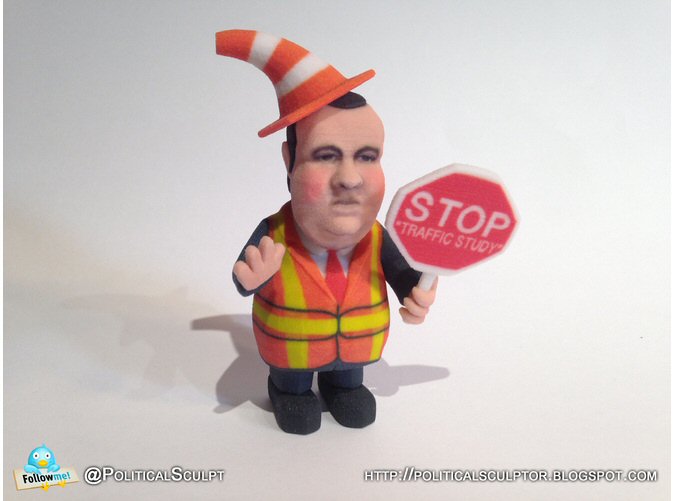
March 2014

Christie figurine, proudly made in USA on a 3D printer, buy it here.
Go to http://politicalsculptor.blogspot.com/ to vote on future modeling subjects!
Everyone knows that Chris Christie was responsible for nearly pinching off the traffic into Fort Lee last September, even if he won't admit it. Hey, pinch-off is a microwave word, pay attention, this is all relevant! Many failed presidential candidates were born liars, like Pat Robertson. Did you know he can leg press 2000 pounds? Pat's co-host is named Kristie Watts, hopefully she is banking some long green for tolerating his hate mongering. How did we get on the subjects of hate and weight when discussing Chris Christie?
Pat hefts 1000 lbs on his amazing quads
Chris Christie is not alone when it comes to being a disgraceful governor, recent examples include Pat McCrory of North Carolina (don't put on your stupid-hat) and Bob McDonnell of Virginia. In honor of GomacTech which starts on March 31, a government-approved conference on microcircuits, we offer the big CC's lost abstract. This was contributed by Dr. Al, thanks again.
Traffic Study by Chris Christie Administration
A study was commissioned and executed having the following congruent but orthogonal goals:
- To determine time lapse parameters for traffic motility through an artificially constricted channel
- To measure levels of conflict versus cooperation exhibited by vehicle operators under incremental stress conditions
- To validate the claim that a space cannot be occupied isochronously by two or more objects of rigid mass
Experimental conditions. The study was held over four consecutive weekdays in September 2013; a similar span of four weekdays was randomly selected as the control period. Subjects comprised the totality of automotive commuters residing in Ft. Lee, NJ and employed in New York City. For the duration of the test period, two of the standard three lanes from Ft. Lee to toll booths on the George Washington Bridge were rendered inaccessible, using chromatically conspicuous markers of negligible obstructive capacity but high semiotic impact. Test conditions were maintained for 96 hours, including four discrete periods of “rush hour” traffic.
Metrics. Each vehicle was timed from its entrance to the on-ramp until its exit from the toll booth. (Time spent waiting to access the on-ramp was specifically excluded.) Mean, median, and range were calculated across recorded times. Merging behavior was observed and categorized: instances of turn-taking were coded as “cooperative,” while instances of bogarting, swearing, ramming/scraping fenders or bumpers, throwing of objects, screaming, sobbing, fistfighting, and vehicle abandonment were coded as “conflict.” Finally, vehicle positions were tracked and analyzed for any degree of imbrication.
Quantitative Results. Time from on-ramp to toll booth exhibited a mean of 4.2 hours per vehicle, with a median of 4.1 hours. Standard deviation was remarkably low, as total data population spanned 3.95 to 4.4 hours. Initial position prior to accessing the on-ramp had no significant effect on subsequent velocity.
Merging behavior tended overwhelmingly towards “conflict.” This trend was pronounced from the beginning of the study (87.6%, p=0.01) and intensified to record levels (98.4%, p=0.001) after the initial 24 hours.
Surprisingly, the hypothesis that rigid objects cannot share lateral or longitudinal positions was proven false. On no fewer than 16 occasions, a vehicle attempting to bogart was impeded by a vehicle refusing to yield, with a resulting comingling of fenders and bumpers such that the vehicles could no longer be said to occupy independent positions.
Discussion and Conclusions. The commuter population described is constrained to traverse the George Washington Bridge inbound to New York, as the Hudson River otherwise constitutes an absolute barrier to ingress via automobile. The bridge’s baseline channel (three lanes) has been viewed as minimally sufficient for the standard volume of commuters, as it is notoriously subject to congestion and delays, particularly under peak traffic conditions ( “rush hours”), during which the time from on-ramp to toll booth may be as high as 32 minutes. Our study has demonstrated that reducing this channel by two-thirds results in measurable degradation of commuting efficiency. Further study is indicated: if augmentation of the normal channel by up to two additional lanes can be shown to produce comparable but opposite effects, we may tentatively accept that there is an inverse correlation between number of lanes accessible and mean/median commute times.
The analysis of driver behavior was still more compelling. By the end of the initial 24 hours, instances of cooperation had become an extreme anomaly, with conflict behavior achieving record levels in both relative and absolute terms. If the study is repeated, additional correlative measures of commuter stress might be gathered by means of questionnaires (comprehensive) or portable blood pressure monitors or other biometrics (random sampling). However, it is our recommendation that personnel soliciting such data be equipped with maximal protective gear, up to and including Tasers for emergencies.
And lastly, the Second Principle of classical physics has been conclusively disproven. When operated by drivers in extreme conflict mode, multiple vehicles may in fact be forced into coterminous space. Fisticuffs and profanity almost invariably ensue. Again, further study is indicated.